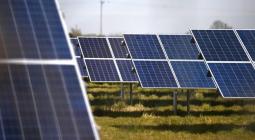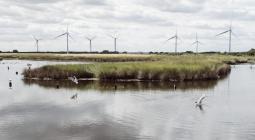‘It was an accident’: the scientists who have turned humid air into renewable power

In the early 20th century, Serbian inventor Nikola Tesla dreamed of pulling limitless free electricity from the air around us. Ever ambitious, Tesla was thinking on a vast scale, effectively looking at the Earth and upper atmosphere as two ends of an enormous battery. Needless to say, his dreams were never realised, but the promise of air-derived electricity – hygroelectricity – is now capturing researchers’ imaginations again. The difference: they’re not thinking big, but very, very small.
In May, a team at the University of Massachusetts (UMass) Amherst published a paper declaring they had successfully generated a small but continuous electric current from humidity in the air. It’s a claim that will probably raise a few eyebrows, and when the team made the discovery that inspired this new research in 2018, it did.
“To be frank, it was an accident,” says the study’s lead author, Prof Jun Yao. “We were actually interested in making a simple sensor for humidity in the air. But for whatever reason, the student who was working on that forgot to plug in the power.”
The UMass Amherst team were surprised to find that the device, which comprised an array of microscopic tubes, or nanowires, was producing an electrical signal regardless.
Each nanowire was less than one-thousandth the diameter of a human hair, wide enough that an airborne water molecule could enter, but so narrow it would bump around inside the tube. Each bump, the team realised, lent the material a small charge, and as the frequency of bumps increased, one end of the tube became differently charged from the other.
“So it’s really like a battery,” says Yao. “You have a positive pull and a negative pull, and when you connect them the charge is going to flow.”
For their recent study, Yao’s team have moved on from nanowires, and instead are punching materials with millions of tiny holes, or nanopores. The device they have come up with is the size of a thumbnail, one-fifth the width of a human hair, and capable of generating roughly one microwatt – enough to light a single pixel on a large LED screen.
So what would it take to power the rest of the screen, or indeed a whole house? “The beauty is that the air is everywhere,” says Yao. “Even though a thin sheet of the device gives out a very tiny amount of electricity or power, in principle, we can stack multiple layers in vertical space to increase the power.”
That’s exactly what another team, Prof Svitlana Lyubchyk and her twin sons, Profs Andriy and Sergiy Lyubchyk, are trying to do. Svitlana Lyubchyk and Andriy are part of the Lisbon-based Catcher project, whose aim is “changing atmospheric humidity into renewable power”, and along with Sergiy they have founded CascataChuva, a startup intended to commercialise the research. They first began working on the idea in 2015, some time before Yao’s team at the UMass Amherst. “We were considered the freaks,” says Andriy. “The guys who were saying something completely impossible.”
In fact, trying to prove the worth of an early proof-of-concept at conferences had them literally red in the face. He says: “The signal was not stable and it was low. We were able to generate 300 milliwatts, but you had to put all your effort into your lungs in order to breathe enough humidity into the samples.”
They’ve come a long way since then, with Catcher and related projects receiving nearly €5.5m (£4.7m) in funding from the European Innovation Council. The result is a thin grey disc measuring 4cm (1.5in) across. According to the Lyubchyks, one of these devices can generate a relatively modest 1.5 volts and 10 milliamps. However, 20,000 of them stacked into a washing machine-sized cube, they say, could generate 10 kilowatt hours of energy a day – roughly the consumption of an average UK household. Even more impressive: they plan to have a prototype ready for demonstration in 2024.
A device that can generate usable electricity from thin (or somewhat muggy) air may sound too good to be true, but Peter Dobson, emeritus professor of engineering science at Oxford University, has been following both the UMass Amherst and Catcher teams’ research, and he’s optimistic.
“When I first heard about it, I thought: ‘Oh yes, another one of those.’ But no, it’s got legs, this one has,” says Dobson. “If you can engineer and scale it, and avoid the thing getting contaminated by atmospheric microbes, it should work.”He goes on to suggest that preventing microbial contamination is more an “exciting engineering challenge” than a terminal flaw, but there are far greater problems to overcome before this technology is powering our homes.
How do these devices get manufactured?” asks Anna Korre, professor of environmental engineering at Imperial College London. “Sourcing raw materials, costing, assessing the environmental footprint, and scaling them up for implementation takes time and conviction.”
Even once the remaining challenge of connecting thousands of these devices together has been overcome, cost remains a significant issue. “All new technologies for energy need to think of the ‘green premium’,” says Colin Price, a professor of geophysics at Tel Aviv University, referring to the additional cost of choosing a clean technology over one that emits more greenhouse gases. “The green premiums are huge at the moment for this technology, but hopefully would be reduced by R&D [research and development], investments, tax breaks for clean energies and levies on dirty energies.”
The Lyubchyks estimate that the levelised cost of energy – the average net present cost of electricity generation for a generator over its lifetime – from these devices will indeed be high at first, but by moving into mass production, they hope to lower it significantly, ultimately making this hygroelectric power competitive with solar and wind. For that to work, though, they’ll need investment, access to raw materials and the equipment to process them.
While the UMass Amherst researchers are working with organic materials, which in theory can be produced with relative ease, the Catcher team have achieved superior results using zirconium oxide – a material of interest in fuel cell research. The Lyubchyks had hoped to establish a supply from their native Ukraine, which has rich deposits, but Russia’s continuing full-scale invasion of the country has forced them for the time being to work with relatively small amounts bought from China.
The team accept that it may take years to optimise a prototype and scale up production, but if they’re successful, the benefits are clear. Unlike solar or wind, hygroelectric generators could work day and night, indoors and out, and in many places. The team even hope one day to make construction materials from their devices. “Imagine you can construct parts of a building using this material,” Andriy says. “There’s no need to transfer the energy, no need for infrastructure.”
It may all seem like blue-sky thinking, and Tesla’s dreams of limitless electricity from the air are still a long way off, but Yao suggests we may find grounds for optimism among cloudier skies. “Lots of energy is stored in water molecules in the air,” he says. “That’s where we get the lightning effect during a thunderstorm. The existence of this type of energy isn’t in doubt. It’s about how we collect it.”
cover photo:Lightning over the Golden Gate Bridge, San Francisco, September 2017. Photograph: Josh Edelson/AFP/Getty Images






